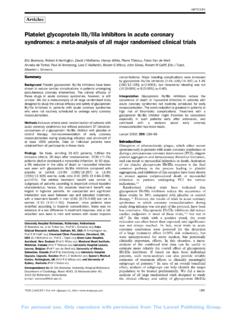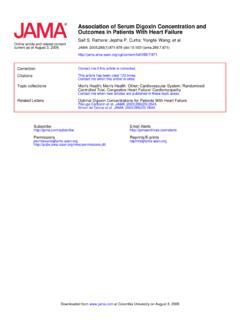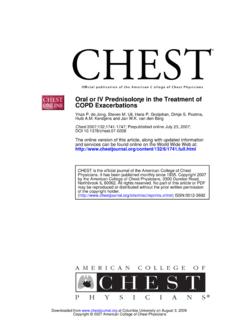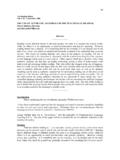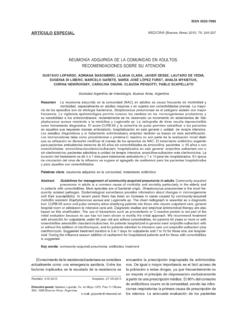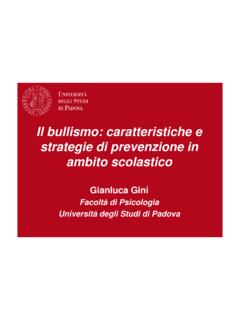Transcription of The RIFLE criteria and mortality in acute kidney injury: A ...
1 The RIFLE criteria and mortality in acute kidneyinjury: A systematic reviewZ Ricci1, D Cruz2,3and C Ronco2,31 Department of Pediatric Cardiosurgery, Bambino Gesu`Hospital, Rome, Italy;2 Department of Nephrology, Dialysis and Transplantation,S Bortolo Hospital, Vicenza, Italy and3 International Renal Research Institute Vicenza (IRRIV), Vicenza, ItalyIn 2004, the acute Dialysis Quality Initiative workgroupproposed a multilevel classification system for acute kidneyinjury (AKI) identified by the acronym RIFLE (Risk, Injury,Failure, Loss of kidney function, and End-stage kidneydisease).
2 Several studies have been published aiming tovalidate and apply it in clinical practice, verifying whetheroutcome progressively worsened with the severity of AKI. Aliterature search from August 2004 to June 2007 wasconducted: 24 studies in which the RIFLE classification wasused to define AKI were identified. In 13 studies, patient-leveldata on mortality were available for Risk, Injury, and Failurepatients, as well as those without AKI (non-AKI). Death wasreported at ICU discharge, hospital discharge, 28, 30, 60, and90 days. The pooled estimate of relative risk (RR) for mortalityfor patients with R, I, or F levels compared with non-AKIpatients were analyzed.
3 Over 71 000 patients were includedin the analysis of published reports. With respect to non-AKI,there appeared to be a stepwise increase in RR for deathgoing from Risk (RR ) to Injury (RR ) to Failure( , for all). There was significant intertrialheterogeneity as expected with the varying patientpopulations studied. The RIFLE classification is a simple,readily available clinical tool to classify AKI in differentpopulations. It seems to be a good outcome predictor, with aprogressive increase in mortality with worsening RIFLE also suggests that even mild degrees of kidney dysfunctionmay have a negative impact on outcome.
4 Further refinementof RIFLE nomenclature and classification is International(2008)73,538 546; ;published online 26 December 2007 KEYWORDS: acute renal failure definition; epidemiology; outcome; RIFLE criteriaDespite several advances in our treatment and understandingof the pathogenesis of acute kidney injury (AKI), manyaspects in this field remain subject to controversy, confusion,and lack of consensus. One of these important aspects is thedefinition of AKI; in fact, it can neither be proven nor deniedthat someone has AKI unless one agrees ahead of time onwhat the term means, as this syndrome is mostly an artificialconcept.
5 The scientific community needs a clear consensusdefinition to describe and to understand epidemiology, torandomize patients in controlled trials, to test therapies insimilar groups of patients, to develop animal models, and tovalidate diagnostic tests. To make consensus-based recom-mendations and delineate key questions for future studies,the acute Dialysis Quality Initiative (ADQI) workgroupidentified a definition/classification system for considered that the definition of AKI necessarilyrequired the following features: ease of use and clinicalapplicability across different centers; sensitivity and specifi-city for different populations and research questions;consideration of creatinine change from baseline.
6 Andimplementation of classifications for acute on chronic renaldisease. A classification system should therefore include anddistinguish between mild or severe, and early or late would allow such a classification to detect patients inwhom renal function is mildly affected (high sensitivity forthe detection of kidney malfunction but limited specificityfor its presence) and patients in whom renal function ismarkedly affected (high specificity for true renal dysfunctionbut limited sensitivity in picking up early and more subtleloss of function).
7 Accordingly, a multilevel classificationsystem was proposed, in which the complete spectrum ofacute renal dysfunction could be included, such as Riskof renal dysfunction, Injury to the kidney , Failure or Loss ofkidney function, and End-stage kidney disease; these criteria (Figure 1) are identified by the acronym RIFLE . Of course, ifpatients are admitted with AKI without any baseline measureof renal function, a theoretical baseline serum creatininevalue for a given patient assuming a normal glomerularfiltration rate (GFR) should be estimated. By normalizing theGFR to the body surface area, and assuming a GFR ofapproximately 75 100 ml min 1per m2, the simplified modification of diet in renal disease formula was selected bythe workgroup to provide an estimate of GFR relative International Society of NephrologyReceived 12 December 2006; revised 22 September 2007; accepted 9 October 2007.
8 Published online 26 December 2007 Correspondence:Z Ricci, Department of Pediatric Cardiosurgery, BambinoGesu`Hospital, Piazza S Onofrio, Rome 00100, : International(2008)73, 538 546serum creatinine based on age, race, and sex: estimatedGFR 75 (ml min 1per m2) 186 (serum creatinine(SCr)) (age) ( if female) ( ifblack).2 After the proposal by the ADQI workgroup in 2004, 24studies were published3 26(Table 1) with the aim to validatethis classification or apply it in clinical practice. Most of thesestudies evaluated mortality of critically ill patients with AKI inpatients in the first three levels (Risk (R), Injury (I), andFailure (F)) of disease severity.
9 Some authors also wished toverify the degree of sensitivity and specificity of thisclassification and compared RIFLE criteria to more commonlyused severity of illness scores. The aim of this literature searchwas to summarize the clinical literature on AKI as defined bythe RIFLE criteria . A general discussion about the moreimportant studies is also than 71 000 patients were included in the analysis ofpublished reports. Among the 13 studies in which patientlevel data on mortality were available for patients withoutAKI (non-AKI),3 15mortality was in non-AKI patientsand in AKI patients.
10 mortality was , , in class Risk, Injury, and Failure, respectively. Withrespect to non-AKI patients, there appeared to be a stepwiseincrease in relative risk (RR) for death going from Risk toFailure: Risk (RR ), Injury (RR ), and Failure(RR ) (Table 2; Figure 2). The comparison between RRfor mortality of patients in different RIFLE classes in differentstudies is shown in Table 2. Although there was significantheterogeneity among the studies as estimated byw2-test, asexpected with the diverse populations studied, the resultswere qualitatively similar for most of them.

